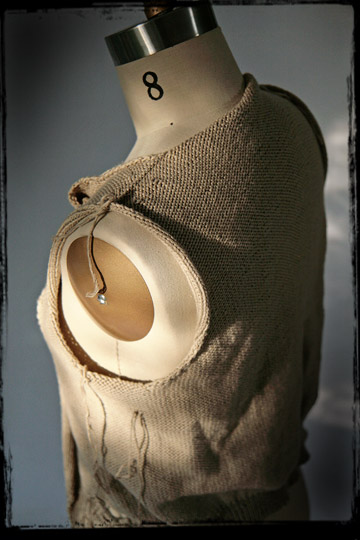 It’s only a Thursday, but there’s something like weekend excitement bubbling up around here. In the Mix: two sweaters ready for my top-down set-in sleeve sampling experiment.
It’s only a Thursday, but there’s something like weekend excitement bubbling up around here. In the Mix: two sweaters ready for my top-down set-in sleeve sampling experiment.
This little cotton number has been ready for a few days and is just waiting for its turn (how it mocks me!) in the workflow (new Fall patterns shipping to LYS – and are they ever beautiful!). I’ve been using these two projects as a dangling Carrot to pull me along the daily grind and be ready in the wings as a reward. The last we heard from this cardi, we were doing a test on some dyeing possibitlies — now we’re ready to get even more adventurous and try a whole new technique.
And there’s a whole lot of info out there about how to do this, so it’s taken a bit of time to sort through it all — very interesting to discover and dig through all the individual takes on the process. I first turned to, but of course, Barbara Walker’s book – and then went online and read all I could…
Here is a great wrap-up of the process by the indomitable Stephanie Thorton: Short-row Set-in Sleeves. She basically sets out the initial way you pick-up-and-knit for this type of sleeve.
Now this isn’t exactly the first time I’ve knit top-down sleeves. Both the Cerisara and the Vonica designs have them.
But this is the first time I’ll be making them on a traditionally shaped (curved after an underarm bind off) armhole. I’ve got a good idea of how I want to consolidate and tweak all the different takes I’ve run across on this process — everyone has a slightly indiviual way they proportion the thing itself, including moi!
If you’ve done this before – leave a comment with any helpful hints? Hold my hand? I’m a little skert!


I’ve done shaped, set-in top-down sleeves several times. It’s really not that scary. Just turn the bind-off sequence upside down, using short rows at the turns.
It’s easier if you start the pick up near the sleeve cap instead of near the armpit. If the sleeve cap has you binding off 14 stitches at the end, then pick up those 14 first, then continue all the way around. When you get to the beginning, knit those 14 sts. YO and turn. Purl back those 14 and 2-3 stitches more (whatever your sleeve pattern says), YO and turn. Keep going until you’ve knit all the way around.
I do a YO and turn, then pick up those yarn over and knit them behind the regular stitch, adding a twist if it looks a bit loose. It’s highly unorthodox, but gives me the best results of any method.
If you are writing your own pattern, just chart it out so that your sleeve and armscythe fit together, using your favorite method. I use a combo of flat pattern measurements and the handy book of knitting patterns.
BTW, I am almost done with Cericera and loving it.
Whoa! Lightbulb! Action! Thank you, Grace — that makes so much sense…
Yes, what Grace said :)
The easiest way is to pick up those 2-4″ at the top of the sleeve cap and then around the armscye. Then work just one more stitch each row until you get to the underarm bind-offs where you’ll add that number of stitches each row until you get them all going.
You don’t have to do any math at all for this one, you just do it. Works great every time.
You do want to be good about picking up stitches. But if you put a safety pin every 2″ around the opening and pick up gauge per inch x 2 between pins, you still aren’t doing much figuring.
If you want a fuller or narrower sleeve you can play with how rapidly you add in the stitches.
Once you do it, you’ll love it! Stitch patterns are “upside down” of course, so it doesn’t work for everything. But you can get sleeve length exactly right!
It really does sound so sensible when you all describe it. I can add no advice…..just a promise when you finish this wonderful pattern I’ll buy it:) Can’t wait to see what’s in store for us!
I have done the top down by both Barbara Walker top down book and Wendy Bernard “Custom Knits”. Both were ok – but the “seam” line is messy. If you find a way to make that look more “set in seamed” you would have something.